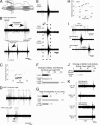Fast noninvasive activation and inhibition of neural and network activity by vertebrate rhodopsin and green algae channelrhodopsin
- PMID: 16306259
- PMCID: PMC1292990
- DOI: 10.1073/pnas.0509030102
Fast noninvasive activation and inhibition of neural and network activity by vertebrate rhodopsin and green algae channelrhodopsin
Abstract
Techniques for fast noninvasive control of neuronal excitability will be of major importance for analyzing and understanding neuronal networks and animal behavior. To develop these tools we demonstrated that two light-activated signaling proteins, vertebrate rat rhodopsin 4 (RO4) and the green algae channelrhodospin 2 (ChR2), could be used to control neuronal excitability and modulate synaptic transmission. Vertebrate rhodopsin couples to the Gi/o, pertussis toxin-sensitive pathway to allow modulation of G protein-gated inward rectifying potassium channels and voltage-gated Ca2+ channels. Light-mediated activation of RO4 in cultured hippocampal neurons reduces neuronal firing within ms by hyperpolarization of the somato-dendritic membrane and when activated at presynaptic sites modulates synaptic transmission and paired-pulse facilitation. In contrast, somato-dendritic activation of ChR2 depolarizes neurons sufficiently to induce immediate action potentials, which precisely follow the ChR2 activation up to light stimulation frequencies of 20 Hz. To demonstrate that these constructs are useful for regulating network behavior in intact organisms, embryonic chick spinal cords were electroporated with either construct, allowing the frequency of episodes of spontaneous bursting activity, known to be important for motor circuit formation, to be precisely controlled. Thus light-activated vertebrate RO4 and green algae ChR2 allow the antagonistic control of neuronal function within ms to s in a precise, reversible, and noninvasive manner in cultured neurons and intact vertebrate spinal cords.
Figures




References
Publication types
MeSH terms
Substances
Grants and funding
LinkOut - more resources
Full Text Sources
Other Literature Sources
Miscellaneous

